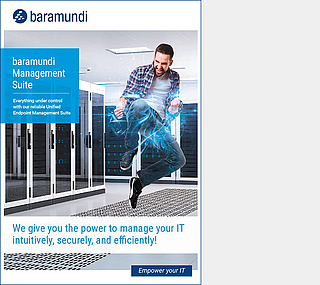Würth
Reference

For any IT professional wanting to understand the biggest benefits of switching from mostly manual endpoint management methods to a unified endpoint management (UEM) system, an IT systems manager at the Würth manufacturing group can immediately name the top three.
“Time, time, and time,” says Hannes Pichler, who along with IT manager Albert Lochmann, implemented the baramundi Management Suite (bMS) at Würth’s Italian subsidiary to manage more than 2,500 network endpoints in 200 locations. “baramundi gives us the power to continuously improve workflows and reduce the time and effort needed for managing endpoints. In particular, software distribution and inventory are now done in no time at all, so it’s easy to see the many benefits that result from that.”
Based in Germany, Würth is a world-renowned creator of fastener and other products for a wide range of industries and applications. Founded in 1945 by a father-and-son team in Künzelsau, Baden-Württemberg, Würth has grown into a €14.4 billion (US$17.4 billion) global leader with more than 400 companies operating in over 80 countries. It produces more than 125,000 products ranging from screws, nuts, bolts and specialized fasteners to chemicals, personal protective equipment, electrical and electronic components and more. Forty percent of Würth’s 79,000 employees are dedicated to sales across the company’s geographic, industry and product areas.
A complex IT infrastructure to meet diverse needs
The large sales force and diverse application areas require a complex IT infrastructure. For example, Würth Italy employs more than 3,600 people from its headquarters in South Tyrol in the northernmost part of the country. In addition to software analysts and consultants, a 60-person IT team provides software development, help desk and operational support, as well as reporting, Big Data and business intelligence services.
“Our hardware and software infrastructure is very diverse,” says Pichler. “In the office, we mainly use laptops and iPads. In addition to standard Microsoft Office applications and SAP for field and office staff, we run logistics software for branch offices and have many custom applications developed in-house. We also have to ensure that all software meets the specific requirements of users in each of those areas.”

UEM puts an end to cumbersome scripting
The IT team decided to look at five different UEM solutions when it became clear that it could not continue to meet growing company and user needs with cumbersome one-off scripts or time-consuming remote sessions.
“The deciding factor was the need to roll out new applications and associated updates for over 1,800 sales representatives. We could not do that without proper endpoint management,” Pichler says." Of all the UEM tools we considered, baramundi provides both ease of use and the power and flexibility to meet our requirements. We particularly liked the ability to use the SDTool to define and implement customized configurations per user based on group membership in Windows Active Directory.”
baramundi Management Suite delivers all of the essential ingredients for IT success.
Hannes Pichler, IT Systems Manager at Würth
Rapid implementation despite the pandemic
Installation of the bMS inconveniently coincided with the dramatic changes in everyday life and increases in IT workloads at the height of the coronavirus pandemic in 2020. Nevertheless, the system was fully installed and operational networkwide within a month. baramundi partner ACS Data Systems played a key role by overseeing the installation remotely using Webex.
Making time for new projects and generating added value
With the time-savings and efficiencies enabled by bMS, the IT team approaches major software deployments such as the Windows 10 20H2 update with confidence. It also has time to plan and complete new projects.“baramundi Management Suite delivers all of the essential ingredients for IT success. It amplifies the capabilities of any good IT team and makes it possible to generate major added value for your company and your users.”

